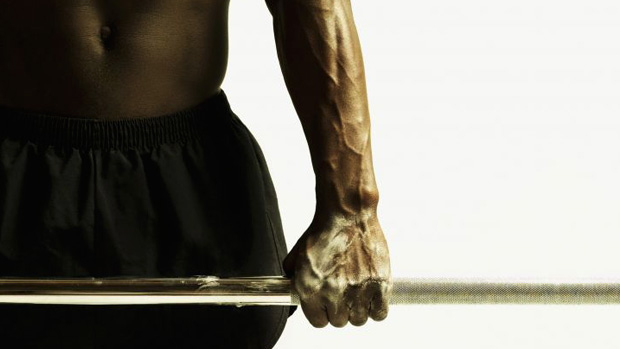Some of you might have enjoyed the Diary of a Steroid User series as much as I did. It was an interesting, unapologetic, honest portrait of what it's like when an average Joe uses steroids. But however much I enjoyed it, I cringed when I read some of the "pyramid" workouts outlined by the anonymous author.
This workout approach is a prime example of a badly designed program that'll yield poor results, even using steroids! I'm not sure you can even call this program "designed," as it's so lacking in merit!
While I've learned to stifle myself when some mullet is doing curls or stretching in the power rack, I can no longer remain rant-free when it comes to three gigantic errors I see every day in the gym, and in every other gym I've trained in for the past twenty years. The saddest thing is that it's not just mullets who make these mistakes.
Do you make these dead-end mistakes? Let's find out.
 |
The 3 Dead-Ends
Dead-End #1: Pyramids
This poor excuse for a training approach is the bad combination of lack of training information coupled with reading too many bodybuilding magazines.
What really matters in training is the number of reps you do, and the average intensity you do them with at a certain percent of your 1RM in a given training period. Not a percent of your lowered 1RM because you're worn out by previous efforts, but your fresh-as-a-daisy 1RM for that day. This percent is called intensity.
Pyramids, done the normal way of working close to failure on the way up the pyramid and then on the way down, are a waste of hard work. Let's look at the workout used in the "Diary" series as an example:
215 x 8
240 x 6
275 x 4
305 x 2
285 x 4
315 x 1
245 x 6
225 x 9
Later on in the article, Anonymous estimates his max at 330-340 pounds, and in another workout he did 325 x 1 after a 305 x 2, so this is a good enough estimate. (Total volume=9820 rep-lbs. 40 total reps. 9820/40=245.5 lbs. 245.5/335=73% of 1RM was his average rep.)
A few things jump out right at the start. First, he never actually did his estimated max. He was always worn out before he got to his top set! Second, he gets more poundage and reps on the way down the pyramid with essentially the same loads as on the way up. Forgetting optimal rep range arguments and muscle fiber targeting concerns, and just using the two conclusions that Anonymous could've reached on his own, we can unscrew the hard upwards/hard downwards pyramid approach.
If you save yourself while working up to your heavy sets, you'll yield a higher top end set and then get more reps on the way down the pyramid, and you'll get much better results. If Anonymous did the following workout after warm-ups:
225 x 3
275 x 2
335 x 1
315 x 2
305 x 3
295 x 4
275 x 5 x 3
255 x 6 x 2
... then his total volume would be down a bit to 9740 rep-lbs, but the average rep would be with 263.24 lbs, about 78% of 1RM. This is clearly a better workout, and even though a bodybuilder has little business doing singles and doubles (ever see anybody do a max single in the bent row?), everybody looks pretty cool repping with six plates. Chicks dig six plates. Even if he did a 225 x 10 down set, his average rep is still up over 255 (76%) verses 245, and his volume is up from 9820 to 11990 rep-lbs.
Lets take this idea even further and do 10 sets of 3 with somewhere between 80 and 85% of a 1RM. 80% is 268 and 85% is 285. So a three-week cycle of 265 x 3 x 10 on week one, 275 x 3 x 10 on week two, and 285 x 3 x 10 on week three saves us painful calculator burn and gives us 30 reps at a minimal intensity of 80%.
Yes, volume is down a bit only doing 30 reps, but try this at home and you'll be glad you only have 30 reps to do instead of 40 or more. If you eat enough, you might even need a new wife beater T-shirt.
Dead-End #2: Western Periodization
Whenever I read some ivory tower academic talk about the breaking down of training into hypertrophy, strength, speed/power, and peaking periods or mini-cycles, with volume dropping and intensity increasing each week, I want to rip my shirt off like the Hulk and start dropping a few bionic elbows in the land of academia. While my kids find this behavior wildly amusing, my wife and neighbors are somewhat put off by my ranting while climbing up on high things. That is why I'm here at T-Nation writing, not at Modern Psychology or Cat Fancy.
Still, it can't be said often enough that doing 4 sets of 10 for a month won't have any carryover to doing 3 sets of 3 a few months later. The precipitous drop in volume, even training with more intensity, will leave you smaller. Fatter too, if you keep eating the same amount and you drop your workload. Even worse, the periodization influenced idea that you build mass with heavy weights, low reps and plenty of food, then "cut it up" with high reps and huge dietary restrictions, is even more insane.
The principle of specificity says in essence that you get very good at what you do a lot of, and when you stop doing something a lot, you get less good at it. So again, avoiding specific muscle fiber recruitment discussions, the muscle you build with hard, heavy volume and intensity in multi-joint movements isn't held when changing to "squeeze and pump" isolation exercises done for higher volumes and lower intensity. Cutting your food back when changing your workout just makes the shriveling more Ethiopian.
As Bear Bryant used to say, "Dance with the one who brought ya." If you want to do higher rep pump and squeeze work, then stay with it for your whole cycle and add volume and slightly decrease food intake as you cut up. Diet isn't my area of expertise, but if you want to lose fat you have to eat a bit less. Shocking, I know. Simple, too! A good guideline is to eat enough to continue to fuel your workouts at the same level of intensity and with some added volume. Skipping the pizza, dessert and beer works remarkably well for this, and your workouts won't suffer at all.
If you want to train hard and heavy, again stay with it and maintain that volume and intensity, and then slightly increase this workload as you slightly reduce food intake. Add some low impact cardio (kettlebell swings and incline treadmill are great for this and have no impact even on your squats), and you're in business.
One caveat: If you're looking for pro-bodybuilder results, you'll be disappointed. You will just not be as freaky as them. You will, however, be able to run up steps and reproduce, or at least practice reproducing without a heart monitor. I guarantee you'll do better around the opposite sex when not wearing a heart monitor.
Dead-End #3: Instinctive Training
Failing to plan is planning to fail. Walking into the gym and deciding what exercise or body part you're going to train that day or what approach you're going to use is the prerogative of enormous genetic freaks awash in a nutrient bath you'd have to risk federal indictment...or Mexican prison, to copy.
While I don't advocate writing a mission statement via your Blackberry or in your Day Planner, I do advocate getting out a paper calendar and verifying that your four to six days a week double-split approach doesn't get in the way of your job, school or family. Believe it or not, your training is more impacted by your life, than your life by your training.
Yeah, I know there are some serious hardcore dudes out there whose entire life is training. Then you get a job, a family and a lawnmower that won't start the morning of your daughter's birthday party. Think you're off to the gym on Saturday morning to squat and deadlift and the party pony will just eat the grass down to a safe and attractive height before the other guests arrive? Do you think you want to be doing all your pulling work at the gym on the nights of your son's football games or your wife's MBA class?
You need to take a look at your life in two dimensions. That six days a week double-split may not work, so you go with three days full-body, five days of one exercise a day, or two upper body and two lower body days. You review the myriad training articles you have read at T-Nation and you decide on an approach you prefer. You, of course, are going to build in back-off weeks every fourth week as I've advocated in a previous article.
Back-off weeks are great to build in when business, school or other issues take you out of town or out of commission and a big training week just isn't in the cards. You're not limited to every fourth week if your schedule or body demands less. Plan out your training overlaid with all your other life commitments, and you have maximized your ability to carry out your training plan.
Can you plan on and consider everything? Nope, but a good plan carried out now is better than a great plan carried out next fall, or no plan at all. That, in a nutshell, is what having a plan is all about: making sure that you've given yourself the maximum chance to hit good workouts and not miss many, if not any, workouts. Too hard to never miss workouts, you might think? In almost 30 years of training, the number of workouts I've flat-out missed I can count on one hand. Some of that was from my hardcore phase as a much younger man, but the most important thing is having a plan ahead of time, then carrying it out.
There's an old saying that no plan survives contact with the enemy, and in my training and professional life, that saying rings true. Having the plan ahead of time gives you something to deviate from, with your options and opportunities already considered to a great extent. You can tweak your plan on the fly and keep getting those workouts in.
Keep in mind that no individual workout is as important as the sum of all your workouts in a training cycle, a year, or your body of work.
The Loophole: Innocence and Experience
In the early 1800's, British poet William Blake published a series of poems and engravings on the contrary states of the soul that occur as we progress from the innocence of youth to the assumptions and knowledge that come with experience. I think this process is a cycle, and it can be applied in life and in training.
As we grow and change, as we become experienced, some of the principles we learn as innocents need to be returned to, in part to help us progress even further. All of the dead-ends I've covered in this article are things we all started out doing in our training, yet they should eventually have fallen behind us as we got bigger, stronger and more educated. Those who didn't let these things fall behind them can be identified as mullets and are known to wear genie pants and do-rags while asking you to upright row three forced reps with 135, as they do something like benching, only funnier.
Every once in a while though, despite all our knowledge and experience, we need to return to the simple approaches we learned as innocents. For example, the hard up/hard down pyramid isn't optimal, but when done keeping a bit in the tank on all sets, we see a very productive workout like the Sheiko bench press marathon.
Another loophole is that while focusing on one training approach is proven best for the most part, you can occasionally do a body part with hard and heavy multi-joint moves like squats, benches, rows, deadlifts, military presses, etc., then finish off with a higher-rep isolation movement like lunges, dumbbell press or flyes, stiff leg or Romanian deadlifts, or dumbbell work in the same workout, or even in two different workouts for a body part in the same week. Westside barbell trains max effort one day and speed the other training day in the same week.
While I'm personally a low rep, high set trainer, there are times I'm so fried after my main exercise that I admit I sometimes don't do low reps on assistance. Even more shocking, I don't plan my upper back work. After whatever else I'm doing that day, I hammer my back with what the gym I'm training in that day has to offer. Generally it's heavy and sets of 5-6 reps. Sometimes it'll be plain old V-grip pulldowns for 3-4 sets of 10. Surprisingly, my sense of guilt doesn't prevent me from sleeping that night!
The final example of the loophole is the most important, and the most difficult to learn. The great powerlifter John Kuc said once that the hardest part of training drug-free is the randomness of when bad days spring up. If you use the three weeks hard, one-week back-off approach, you minimize this phenomenon. There are days, sometimes identifiable by a huge life stressor, physical illness, or missed meals, missed sleep or a missing training partner, where you just don't have it. Other times these days come out of nowhere.
I don't mean not feeling like training, or having shaky warm-ups. I mean zero in the tank, zero in the heart, and zero in the head. This happens to everybody, and despite my ranting about staying with a plan and not winging it on instinct, on these days you just need to go home.
As my brother told me once after a shaky two reps with what should have been a challenging five rep set of squats, "Nothing wrong with you that a good night's sleep and five meals won't fix." We picked up our stuff and left, hitting a buffet on the way home and then eating a great dinner. Those same five reps rocketed right up the next day.
One Final Thought
Everything works in training, and everything stops working eventually. We must constantly evolve and devolve our training, and stay ahead of our body's amazing ability to adapt. Hopefully this article gives a means of approaching this with some care and thought.




